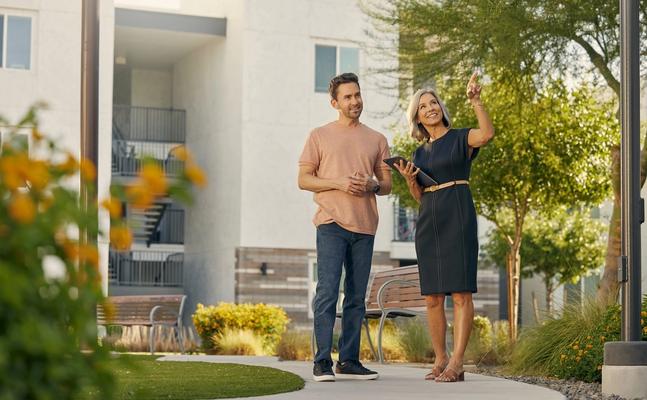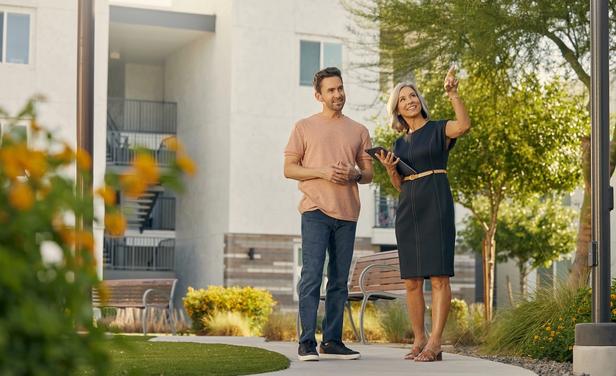Subscribe to our newsletter
Key Takeaways:
Smart Tech transforms labor dynamics: In a tight labor market, smart home technology fundamentally reshapes multifamily operations, empowering site teams to achieve more with existing resources and significantly reduce stress and burnout.
Automates high-volume, repetitive tasks: Smart devices (e.g., locks, thermostats, leak detectors) automate routine, time-consuming duties like unit checks, move-in preparations and property walks, freeing up staff for high-value, resident-facing interactions.
Enables proactive, predictive maintenance: IoT sensors allow teams to shift from reactive emergency responses to proactive maintenance by providing early alerts for potential issues, optimizing scheduling, extending asset lifespans and reducing costly emergency call-outs.
Empowers comprehensive remote management: Smart technology facilitates critical tasks like granting access, adjusting unit conditions and receiving alerts remotely, enhancing responsiveness, streamlining operations across multiple properties and improving off-hours efficiency.
Fosters seamless communication and self-service: By providing residents with intuitive control over their smart devices and direct digital channels for requests, smart tech drastically reduces inbound calls and interruptions for staff, creating clearer communication lines and more efficient problem resolution.
Drives data-driven strategic decisions: Real-time data from smart devices offers actionable insights into operational patterns, asset performance and resident behavior, enabling property managers to make more informed decisions on staffing, resource allocation and workflow optimization.
Boosts talent attraction and retention: A tech-enabled workplace reduces daily frustrations and improves efficiency, creating a more attractive and less stressful environment that leads to higher job satisfaction, stronger retention rates and a competitive edge in recruiting top talent.
Introduction
Staffing challenges in multifamily property management aren’t new, but they’re becoming more urgent. With ongoing labor shortages, high turnover and rising expectations from residents and owners alike, site teams are under more pressure than ever to deliver more with fewer resources.
Enter smart home technology, not just as a convenience for residents, but as a workforce multiplier for property teams. By automating routine tasks, enabling remote operations and unlocking new operational insights, smart tech helps communities boost productivity without burning out their teams.
Let’s take a closer look at how smart home solutions are transforming multifamily labor dynamics.

Automating high-volume, repetitive tasks
Much of a property team’s day is consumed by repetitive, yet critical, tasks that demand physical presence and significant time. Consider the hours spent manually verifying unit lock status after a tour, adjusting thermostats to optimal temperatures for new move-ins or conducting physical walk-throughs to spot potential maintenance issues like leaks or excessive energy use. These "swivel chair" tasks and manual checks, while necessary, pull staff away from more strategic, resident-facing activities.
Smart tech solutions like smart access, thermostats and leak detection fundamentally automate or eliminate these time sinks. Leasing agents can remotely verify unit security or pre-set ideal temperatures with a tap on their phone, eliminating the need to physically return to units. Maintenance staff can receive instant alerts from water sensors, pinpointing issues immediately rather than discovering them during routine inspections or after a resident complaint has escalated.
This shift means a leasing agent can handle more tours in a day, a maintenance tech can prioritize critical repairs and staff can significantly reduce unproductive travel time across sprawling properties. It’s not about replacing people; it’s about liberating their time from busywork so they can focus on higher-value tasks that directly impact resident satisfaction and portfolio performance.
Shifting to proactive, predictive maintenance
Maintenance teams are perpetually juggling reactive emergencies with their scheduled routine work. This constant firefighting leads to high stress, inefficient resource allocation and ultimately, higher costs when small issues escalate. Smart home technology fundamentally shifts this balance from reactive to proactive, empowering teams to prevent problems before they occur.
IoT-powered devices like leak sensors, HVAC monitoring and smart appliance diagnostics continually collect data, alerting teams to potential issues before they become emergencies. Imagine a notification indicating unusual water usage, signaling a slow leak or a deviation in HVAC performance, hinting at an impending unit breakdown.
This allows maintenance staff to schedule repairs during regular hours, often before residents even notice a problem, significantly reducing the volume of disruptive late-night or weekend service calls.
This proactive approach leads to more efficient scheduling, allows for route optimization based on real-time data and helps maintenance techs prioritize their workday based on actual asset health rather than constant crisis management. This doesn't just make jobs easier; it extends the life of valuable assets, minimizes costly damages and dramatically improves resident satisfaction by ensuring a consistently functional home environment.
Empowering comprehensive remote management
The ability to manage units and operations remotely is one of the most transformative benefits of smart technology, providing unparalleled flexibility and responsiveness for property managers and maintenance staff. Teams no longer need to be physically present for every task, drastically reducing travel time and enabling more efficient management of large properties or multiple communities.
With SmartRent's centralized platform, site teams can:
Grant temporary, secure access to vendors, prospects or new residents with just a few taps from anywhere, eliminating key hand-offs and waiting times.
Remotely lock and unlock doors for vacant units, during emergencies or for convenient package deliveries.
Adjust thermostats and manage smart lighting from a central dashboard to optimize energy use in vacant units or prepare for showings.
Receive instant alerts for critical conditions like water leaks, extreme temperature drops or smoke detection, enabling rapid, informed intervention.
These remote capabilities translate to fewer physical trips, faster issue resolutions and greater flexibility for staff managing diverse portfolios. In a recent case study, Venterra Realty Management teams partnered with SmartRent to remotely unlock doors, receive work orders and optimize maintenance workflows across 80 properties, reporting significant reductions in service call times and measurable gains in operational efficiency. This kind of digital visibility is especially powerful during off-hours, inclement weather or when staff are stretched thin across multiple communities, essentially giving teams more hours in their day.
Streamlining communication and empowering residents
Every resident call to the front office, whether it's about a locked door, a cold apartment, a package inquiry or a leaky sink, represents time and a potential interruption for site teams. Smart tech significantly reduces this inbound call volume and improves overall communication flow by empowering residents with self-service tools and providing clearer channels for interaction.
With SmartRent's intuitive resident app:
Residents gain direct control over their smart devices (locks, thermostats, lights), resolving many common issues themselves without needing staff intervention.
They can submit and track maintenance requests digitally, reducing phone calls and ensuring all details are captured accurately.
Automated notifications from the system (e.g., work order updates, package arrivals, community announcements) keep residents informed proactively, minimizing their need to call for status updates.
This level of resident autonomy not only improves their experience but also significantly reduces the constant stream of minor inquiries and interruptions for staff. The time saved can be reinvested into more meaningful resident engagement, addressing complex issues or supporting new move-ins—all activities that directly impact satisfaction, build community and strengthen long-term retention. It shifts staff from being mere responders to being proactive community builders.
Smarter teams through data-driven insights
Smart home technology doesn’t just automate tasks; it constantly collects and synthesizes invaluable data, transforming raw information into actionable insights. From entry logs and HVAC usage patterns to leak alerts and amenity booking trends, teams gain real-time, aggregated data they can use to optimize operations and elevate their roles from tactical execution to strategic planning.
With centralized dashboards, property managers can:
Monitor operational patterns across individual units, buildings and entire portfolios, identifying trends in energy consumption, security events or maintenance needs.
Pinpoint inefficiencies and frequent trouble spots, allowing for targeted interventions before minor issues become major headaches.
Make informed, data-driven decisions about staffing levels, scheduling optimization and preventive maintenance priorities based on actual usage and performance metrics.
Track resident engagement with smart amenities and services, informing future amenity investments and community programming.
This level of data-driven decision-making fundamentally elevates the role of site teams. They move beyond reacting to problems to proactively shaping operational strategy, leading to fewer gaps, greater confidence in every decision and a more resilient, optimized portfolio.

Attracting and retaining top talent
In today’s highly competitive labor market, where attracting and retaining skilled property management professionals is a constant challenge, technology serves as a powerful differentiator. A property equipped with modern tools and digital workflows is significantly more attractive to professionals who want to work efficiently, solve problems proactively and avoid the frustrations associated with outdated systems, manual processes and avoidable emergencies.
A tech-enabled work environment also demonstrably reduces stress and burnout among site teams. When staff have intuitive tools that automate tedious tasks, enable remote work, provide real-time data and empower residents with self-service options, they are more likely to feel supported, respected and effective in their roles. This directly translates to higher job satisfaction, increased tenure and a positive reputation as an employer.
While specific industry-wide statistics can vary, studies consistently show that employees in tech-forward environments report higher engagement and lower turnover. Investing in smart technology isn't just beneficial for operational metrics; it's a strategic investment in your team's well-being, professional growth and your company's ability to recruit and retain the best talent.
Doing more with smart tech
SmartRent isn’t just about smart devices; it’s about empowering people. In a labor-constrained environment, automation, remote access and real-time data can give site teams the edge they need to perform, grow and thrive.
With the right technology, your current staff can handle more units, deliver better service and enjoy their work more, all without adding headcount.
Ready to see how the right smart tech can support and empower your team? Discover the power of a smarter workforce—contact us today and let’s talk!

